Much more than a digital Field Notebook, all the information of your farm in your pocket ready for when you need it
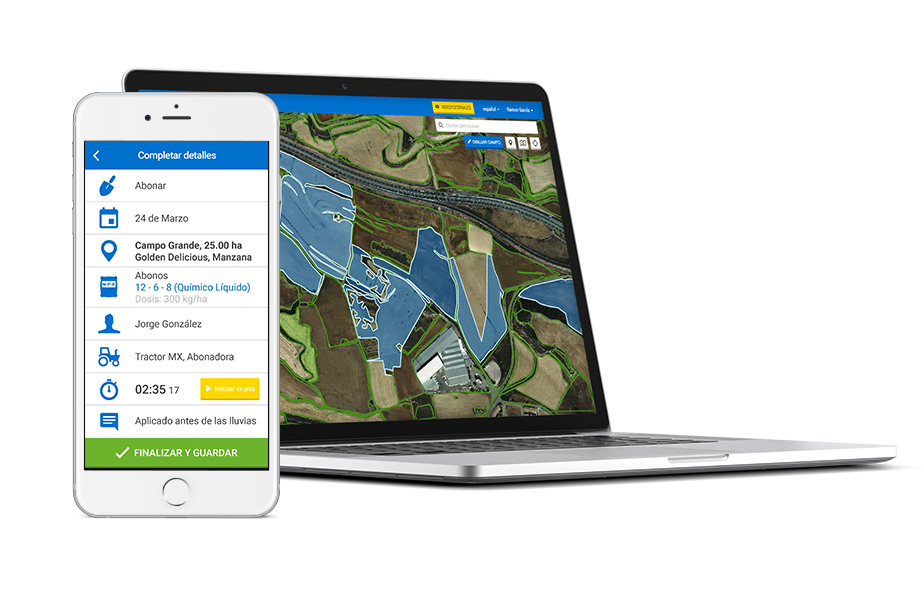
All data in one place and instantly. Everything downloadable in Excel or integrable with your ERP.
Multi-device function to work with your computer simultaneously.
Automatic calculation of agricultural margins for informed decision-making.
Reports in 1 click to comply in the easiest way with traceability.
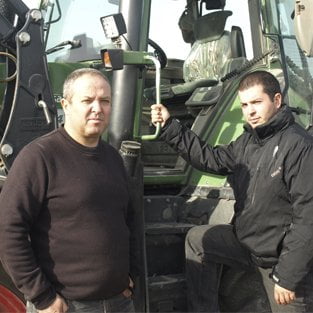
“I used to make a lot of papers. For each plot I make a sheet with two faces and now I do everything in 5 minutes a day.”
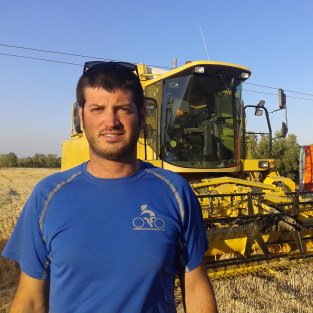
“It’s fantastic to get home with traceability done from the tractor.”

“I’m delighted with Agroptima, how easy it is to enter enclosures and write down everything you want!”
Everything on your mobile phone. Have your farm well organized from anywhere. Note your farm activities (apply phytosanitary, harvest, etc.) from the digital field notebook of the Agroptima app in seconds, while working in the field.
And you can see all your fields on the map of our APP.
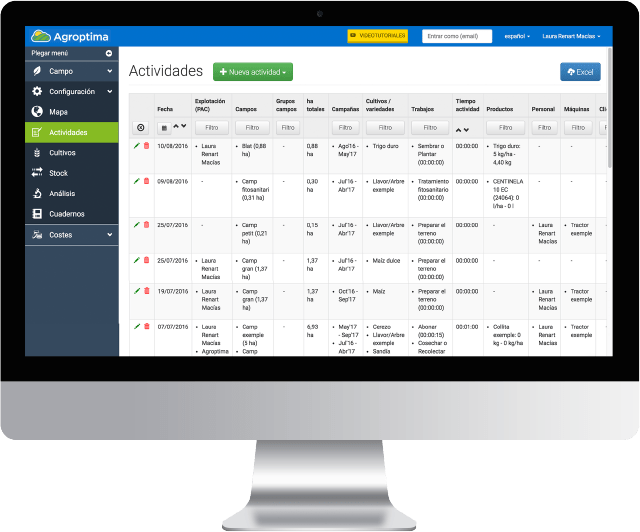

With our App you can work without a 3G or WiFi connection. When you are connected, all the tasks you have noted in the App will be synchronized with your web account. Forget about duplicating your work and come home with all the data on the computer.
Did you know that you can download our App on different devices so different people can work at the same time?
With Agroptima you can download your farm activities reports when you need it, you can download this info in 1 click in Excel with the official MAPAMA format and so you can check it. Saves time and headaches.
Did you know that you can carry more than one farm with the same price? Add different farms to know easily what do you do in each one.

I’m sure you already know what the field journal is, but when we have it in front of us there are doubts about how to fill it out, or we wonder if we are doing it right. With this guide you will be sure that your agricultural field notebook is perfectly completed!
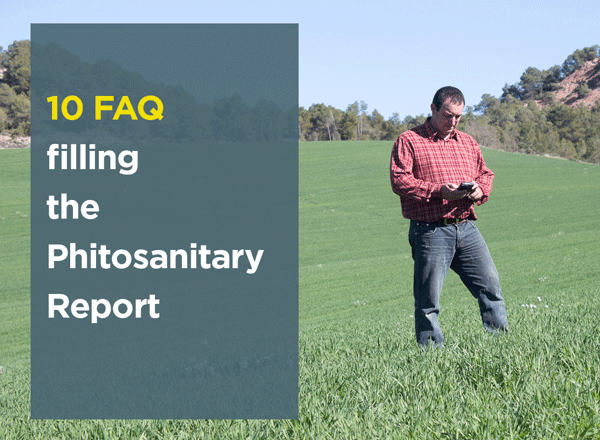
First of all, a small reminder: the agricultural field log is the register or field diary that obliges us to bring the MAPAMA to all professional farmers of our treatments with plant protection products in crops. It is mandatory for all farmers since 1 January 2013 and is governed by Royal Decree 1311/2012 on Sustainable uses of plant protection products.
The workbook is not only to point out the treatments, in fact the model proposed by the MAPAMA on its website and that complies with the above-mentioned law, has up to 12 different paragraphs that must be completed:
In the first section of the Agricultural Field Information Leaflet, General Information there are some boxes which are the registration numbers of National or Regional Holdings. It is very common to ask what these numbers are.
In this case, it is only necessary to put the Autonomic Registration Number, as it is the prevailing one. According to RD 9/2015 of 16 January each Autonomous Community is required to set up a register of agricultural holdings, with the aim of complying with the European rules on food safety.
Your farm should already be registered with the Autonomous Community Register, so if you’ve applied for the PAC for the past two years, check your PAC statement and see if there’s a registration number to put in your farm notebook.
In this section we are asked to identify in the agricultural field journalif the plot is located in an area with certain environmental protection levels. It should not be confused with the Nitrate Vulnerable Zones, which refer to fertilisation.
Article 34 of RD 1311/2012 considers these areas as follows:
This question is very common, the field journal should be by Pacs and include all the plots we declare in the PAC, but nowhere in the regulation is it stated that the order of the LPIS parcels should be the same as the one we have in the PAC statement.
What is logical, and in fact it is proposed in some Autonomous Communities, is that by doing the booklet manually, the list of plots is replaced by a copy of the PAC, so that we do not have to transcribe all the codes.
The treatment registration sections are going to be the most extensive, as all treatments performed in the field will appear. But it is divided into two pages “Normal Treatments” and “Treatments to Crops Subject of Advice”.
This is because RD 1312/2011 itself defines that certain crops need to be advised by an Integrated Pest Management technician, who oversees pest control and good management on the farm. It is the treatment of these crops that will have to appear in the treatment register which is the subject of advice. Already on the same page, the boxes and spaces are included so that the technician can carry out the validation (put his signature on the farm log book).
The lot number that comes in each package does not need to be entered in the field book if you are only a farmer on your own. Those who are obliged to write it down are those who make transactions with them (buy-sell) and keep an eye to the facts, because it is also necessary to keep it in the records of the works that are made of applications to third parties.
REMEMBER to note in the notebook the registration number, each product has its own and will always be the same (does not vary from batch to batch), and is required to be recorded for each note.
We might think that in this section, treatments should only be included if we ourselves paint the seed, but it is not so.
It is already indicated by the name itself “Use of treated seed”. So whether you buy certified seed, or if you have been cleansed and treated your own seed you need to take the label off the sacks to write down in the field notebook the product with which the seed was treated, the dose and on which parcels this seed has been sown.
It is a listing of the sales invoices for our crops. It is very important because it makes it possible to bring the traceability of the food we produce, that is to say, to know the path that has gone from food from the field to the table.
In this section there may be some confusion when identifying the parcels of origin of the product, especially if we store grain from all the parcels in a warehouse and then sell it to several customers, as in this case it is impossible to identify the fields of origin of each parcel. In this case, we can say that the parcels of origin are all those that had said crop planted or planted.
In the same section the last column is the RGSEAA, although it appears as a volunteer field many of us wonder what it means. These are the acronyms of the General Health Register of Food and Food Companies, and the customer to whom we sell the harvest can provide us to put it in the agricultural field notebook.
Finally, the last section of the field journal is the fertilization record, which appears as optional. I suppose you’re wondering if it’s optional, I have to fill it out? Well, this is a sensitive issue, as each Autonomous Community legislates on this issue.
In general the registration of fertilizers should be kept as long as the parcels of the farm are in an area vulnerable to nitrate contamination or if you are also a farmer and have farms.
You should keep in mind that the model proposed by MAPAMA for the phytosanitary registry may not work for you. Some Autonomous Communities adopt the same model, but others do not. Castile-Leon and Andalusia use the MAPAMA model.
In Castile-La Mancha, Aragon and Catalonia, however, the models are different and the one proposed by the Autonomous Community needs to be filled in.
I know what you think after reading all this: too much paper work…”.
But there is a way to keep the field journal in a very simple way, writing down your work on your mobile phone and creating a notebook in a single click with everything we have seen perfectly completed.
With Agroptima you will do the workbook without complications, save time and be more calm! Try it for free 15 days by clicking here
The field carnet is a document in which holders of agricultural holdings must register the processing carried out on their holdings. It is also known as a Working Book, a Plant Protection Notebook or a field book.
The mandatory on to update this document comes from European legislation, and to Spain and in Catalonia it applies according to Royal Decree 1311/2012, Law of Sustainable Use of Plant Protection Products, which indicates the minimum data to be included in the Field Notebook.

RD 1311/2012 was born to preserve the agricultural sector by ensuring a positive contribution to the Environment with a sustainable model in terms of production and a rational use of plant protection products.
Reducing the risks and effects of the use of plant protection products on human health and the environment.
Since 1 January 2013, all Spanish farmers have had to bring their farm logbook up to date, either on paper or in electronic form. This can be requested at any time to verify compliance with cross-compliance in the Common Agricultural Policy (CAP) support, which manages the subsidies granted to agricultural production within the European Union.
The objective of the workbook is to keep a record of all treatments made with plant protection on each farm and therefore for each CAP application.
This makes it possible to monitor phytosanitary treatments, to trace the products grown and to comply with the conditionality of CAP aid.PAC.

The field log is composed of two distinct parts: the general information part of the holding and identification of the parcels and the treatment record part.
Part I. General farm information and identification of parcels: details of the holding and its holder
Part II. Registration of treatments: all treatments made in each field
The field notebook must be kept for a minimum of 3 years, it can be both on paper and on computer.
With Agroptima you can save the information as long as you want, without worrying about data loss. All information is in the cloud and there is no need to worry about backups or total loss of information.
Find out what we’ll do for you
The workbook must be kept up to date, it can be requested at any time, without prior notice from the administration. It is a constant record of all treatments applied.
Other legal documentation to keep up-to-date:
However, the field journal is not the only document that has to be kept up-to-date, you also have to have updated the following documents:
In addition, third-party treatment companies also have to:
The obligation to update the Phytosanitary Notebook is regulated by Royal Decree 1311/2012, this law regulates the Sustainable Use of Plant Protection Products. If the specified thresholds are not met, penalties may be imposed, which will vary according to the reason for the infringement.
In addition to complying with the previous law, the operating carnet is also required to comply with the conditionality of PAC. So you already know.
If you want to keep the Phytosanitary Registration Book up to date and easily write it down from Agroptima, your field journal app.